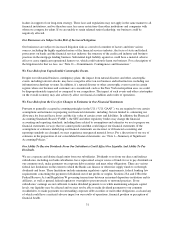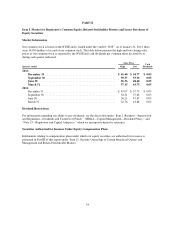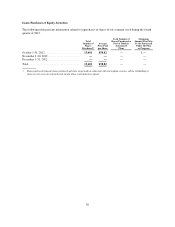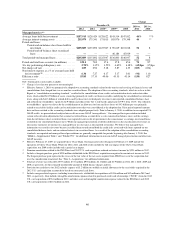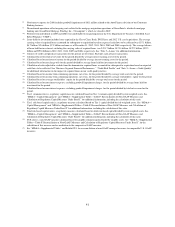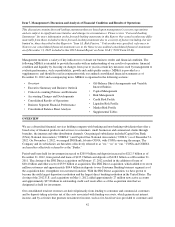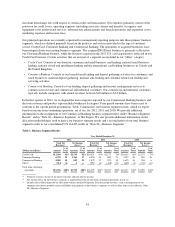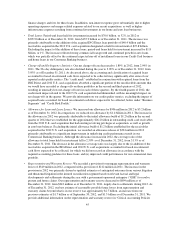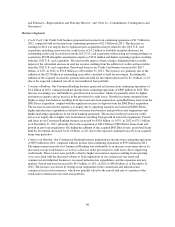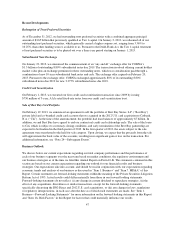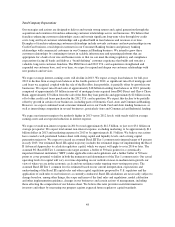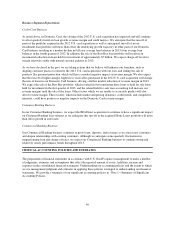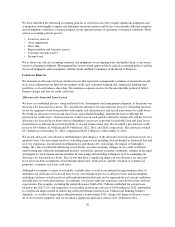Capital One 2012 Annual Report Download - page 60
Download and view the complete annual report
Please find page 60 of the 2012 Capital One annual report below. You can navigate through the pages in the report by either clicking on the pages listed below, or by using the keyword search tool below to find specific information within the annual report.(8) Non-interest expense for 2008 includes goodwill impairment of $811 million related to the Auto Finance division of our Consumer
Banking business.
(9) Discontinued operations reflect ongoing costs related to the mortgage origination operations of GreenPoint’s wholesale mortgage
banking unit, GreenPoint Mortgage Funding, Inc. (“Greenpoint”), which we closed in 2007.
(10) Preferred stock dividends in 2009 and 2008 were attributable to our participation in the U.S. Department of Treasury’s Troubled Asset
Relief Program (“TARP”).
(11) Loans held for investment includes loans acquired in the Chevy Chase Bank, ING Direct and 2012 U.S. card acquisitions. The average
carrying value of acquired loans accounted for subsequent to acquisition based on expected cash flows to be collected was $37.1 billion,
$4.7 billion, $5.6 billion, $7.3 billion and none as of December 31, 2012, 2011, 2010, 2009 and 2008, respectively. The average balance
of loans held for investment, excluding the carrying value of acquired loans, was $151.7 billion, $123.4 billion, $122.2 billion, $92.5
billion and $99.0 billion in 2012, 2011, 2010, 2009 and 2008, respectively. See “Note 5—Loans” for additional information.
(12) Consists of credit card purchase transactions for the period, net of returns. Excludes cash advance transactions.
(13) Calculated based on total net revenue for the period divided by average interest-earning assets for the period.
(14) Calculated based on net interest income for the period divided by average interest-earning assets for the period.
(15) Calculated based on net charge-offs for the period divided by average loans held for investment for the period.
(16) Calculation of ratio adjusted to exclude from the denominator acquired loans accounted for subsequent to acquisition based on expected
cash flows to be collected. See “Business Segment Financial Performance,” “Credit Risk Profile” and “Note 5—Loans—Credit Quality”
for additional information on the impact of acquired loans on our credit quality metrics.
(17) Calculated based on income from continuing operations, net of tax, for the period divided by average total assets for the period.
(18) Calculated based on income from continuing operations, net of tax, for the period divided by average stockholders’ equity for the period.
(19) Calculated based on average stockholders’ equity for the period divided by average total assets for the period.
(20) Calculated based on non-interest expense, excluding goodwill impairment charges, for the period divided by average loans held for
investment for the period.
(21) Calculated based on non-interest expense, excluding goodwill impairment charges, for the period divided by total net revenue for the
period.
(22) Tier 1 common ratio is a regulatory capital measure calculated based on Tier 1 common equity divided by risk-weighted assets. See
“MD&A—Capital Management” and “MD&A—Supplemental Tables—Table F: Reconciliation of Non-GAAP Measures and
Calculation of Regulatory Capital Measures Under Basel I” for additional information, including the calculation of this ratio.
(23) Tier 1 risk-based capital ratio is a regulatory measure calculated based on Tier 1 capital divided by risk-weighted assets. See “MD&A—
Capital Management” and “MD&A—Supplemental Tables—Table F: Reconciliation of Non-GAAP Measures and Calculation of
Regulatory Capital Measures Under Basel I” for additional information, including the calculation of this ratio.
(24) Total risk-based capital ratio is a regulatory measure calculated based on total risk-based capital divided by risk-weighted assets. See
“MD&A—Capital Management” and “MD&A—Supplemental Tables—Table F: Reconciliation of Non-GAAP Measures and
Calculation of Regulatory Capital Measures Under Basel I” for additional information, including the calculation of this ratio.
(25) TCE ratio is a non-GAAP measure calculated based on tangible common equity divided by tangible assets. See “MD&A—Supplemental
Tables—Table F: Reconciliation of Non-GAAP Measures and Calculation of Regulatory Capital Measures Under Basel I” for the
calculation of this measure and reconciliation to the comparative GAAP measure.
(26) See “MD&A—Supplemental Tables” and Exhibit 99.1 for a reconciliation of non-GAAP managed measures to comparable U.S. GAAP
measures.
41


